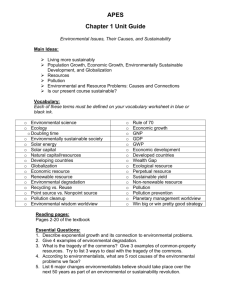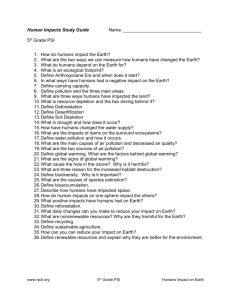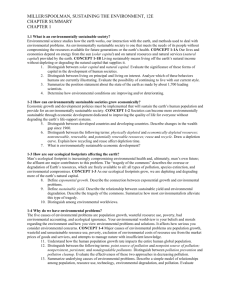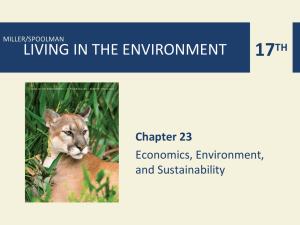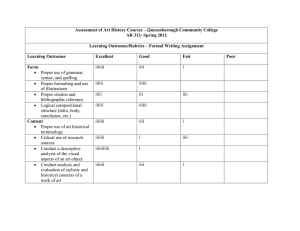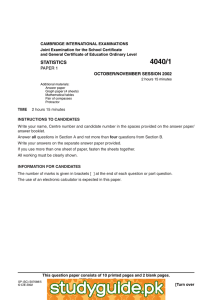File
advertisement
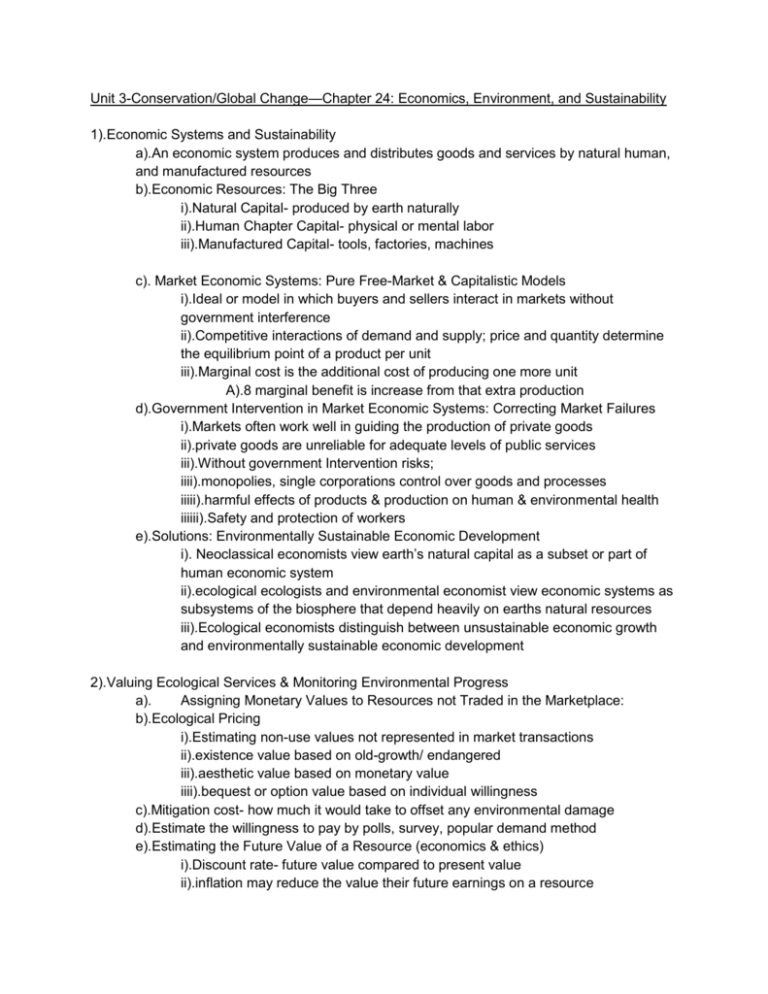
Unit 3-Conservation/Global Change—Chapter 24: Economics, Environment, and Sustainability 1).Economic Systems and Sustainability a).An economic system produces and distributes goods and services by natural human, and manufactured resources b).Economic Resources: The Big Three i).Natural Capital- produced by earth naturally ii).Human Chapter Capital- physical or mental labor iii).Manufactured Capital- tools, factories, machines c). Market Economic Systems: Pure Free-Market & Capitalistic Models i).Ideal or model in which buyers and sellers interact in markets without government interference ii).Competitive interactions of demand and supply; price and quantity determine the equilibrium point of a product per unit iii).Marginal cost is the additional cost of producing one more unit A).8 marginal benefit is increase from that extra production d).Government Intervention in Market Economic Systems: Correcting Market Failures i).Markets often work well in guiding the production of private goods ii).private goods are unreliable for adequate levels of public services iii).Without government Intervention risks; iiii).monopolies, single corporations control over goods and processes iiiii).harmful effects of products & production on human & environmental health iiiiii).Safety and protection of workers e).Solutions: Environmentally Sustainable Economic Development i). Neoclassical economists view earth’s natural capital as a subset or part of human economic system ii).ecological ecologists and environmental economist view economic systems as subsystems of the biosphere that depend heavily on earths natural resources iii).Ecological economists distinguish between unsustainable economic growth and environmentally sustainable economic development 2).Valuing Ecological Services & Monitoring Environmental Progress a). Assigning Monetary Values to Resources not Traded in the Marketplace: b).Ecological Pricing i).Estimating non-use values not represented in market transactions ii).existence value based on old-growth/ endangered iii).aesthetic value based on monetary value iiii).bequest or option value based on individual willingness c).Mitigation cost- how much it would take to offset any environmental damage d).Estimate the willingness to pay by polls, survey, popular demand method e).Estimating the Future Value of a Resource (economics & ethics) i).Discount rate- future value compared to present value ii).inflation may reduce the value their future earnings on a resource 3).ethical concerns in determining how they use and manage such resources complicate business, wages, and trade a).Hidden Harmful Costs b).All goods have internal or direct costs associated with producing them i).additional costs for after the initial payment, ex. repairs, fuel, etc. c).Indirect or external costs aren’t included in the market prices and affect others than the buyer and seller d).The harmful external costs aren’t included make buyers oblivious of the connections they have to the harm e).Estimating the Optimum Levels of Pollution Control and Resource Use i).Optimum levels fluctuate in relation to the equilibrium points in products ii).various levels for kinds of pollution iii).as pollutants are removed the marginal cost increases iiii).Optimum point, the cost of removing pollution can get higher than people are willing to pay f).Cost- Benefit Analysis a).(CBA) tool for deciding how to control pollution and manage resources i).Done by comparing estimated benefits and costs ii).Monetary values complicate this system as individual views are of a wide range iii).Economist use simple guidelines to avoid complications b).Environmental and Economic Indicators: Environmental Radar i).(GDP) Gross domestic product (per capita) indicates a standardized method for measuring economic outputs of nations ii).Environmental scientists call for development and widespread use of new indicators to help monitor environmental quality and human well-being iii).Genuine Progress Indicator iiii).that adds to the GDP items concerning environmental quality are not counted in the market place c).and subtracts GDP costs of things that lead to lower quality of resources 3). Economic Tools for Improving Environmental Quality a).Full-Cost Pricing i).creating an environmentally honest market system ii).requires including the harmful indirect or external costs iii).would encourage producers to pollute less and invent more efficient resources and productions iiii).The benefits this has is rejected for 2 major reasons: A).harmful products & wasteful goods would go out of business B).difficult to price the environmental and health costs b).Eco-Labeling: i).Informing consumers to buy conspicuously ii).product eco- labeling can encourage companies to develop greener products c).Replacing Environmentally Harmful Subsidies with Environmentally Beneficial Subsidies i).To encourage full-cost pricing nations could undergo phasing out environmentally harmful subsidies A)Some countries phase out subsidies like coal for fossil fuels and nuclear power B).Governments could also phase in taxes and environmentally beneficial subsidies d).Shifting Taxes from Wages and Profits to Pollution & Waste i).Green Taxes or Eco Taxes is a way to discourage pollution and resource waste ii).Industries claim taxes will reduce their competitiveness A).Analysts claim there is three requirements to avoid 15-20 yrs for businesses to draft plans for future mechanism to ensure that revenues improve environment e).Using Environmental Laws & Regulations to Encourage Innovation i).Regulation is a form of government intervention in the marketplace A).to control or prevent pollution ii).Innovation-Friendly regulations can motivate environmentally safe processes and create jobs A).also saves money on pollutant clean ups, or harmful disputes f).Using the Marketplace to Reduce Pollution & Resource Use i).government grants companies a certain number of tradable pollution & resource-use permits and sets limits or caps g).Green Economics i).for more sustainable economies focus on shifting from the current material-flow economy to a service-flow economy A).customers eco-lease services that goods could provide document services, chemical services, mobility services 4).Reducing Poverty to Improve Environmental Quality & Human well being a).Distribution of the world’s wealth i).Poverty is the inability to meet one’s basic economic needs ii).Poverty has numerous harmful health and environmental effects iii).The poorest of the rural poor depend on the environment for 80% of their basic needs b).Solutions: Reducing Poverty i).worldwide cooperative efforts to eradicate extreme poverty and stabilize population ii).forgiving the international debts of poor countries iii).easing international aid iiii).small individuals loans iiiii).increase nonmilitary government and private aid to developing countries iiiiii).mount a massive global effort to combat malnutrition c).Solutions: Achieving the Millennium Development Goals i).in 2000, nations of the world meeting at the United Nations Millennium Summit adopted stewardship goals 5).Making the Transition to more Environmentally Sustainable Economies a).Making the transition to eco-Economies i).“Leave the world better than you found it, take no more than you need,..” ii).(EPI) Environmental Performance Index help evaluate the progress of 133 nations toward sustainability b).Case study: The Netherlands i).In 1989, implemented a National Environmental Policy Plan ii).goal was 70-90% decrease in pollution iii).task force of people in the industry, government, and citizens A).8 areas of focus iiii). result ranked 27 of 133 nations on the 2005 EP c).Jobs, Profits, and the Environment i).shifting to an eco-economy will require phasing out some old industries, restriction other industries and creating new ones ii).the cost of new research and development will be outweighed by the benefits of more jobs This chapter is about different economic systems, ecological services, and more. Some economic systems are market economic systems and government intervention in market economic systems. This chapter also explains some solutions to these problems. Valuing ecological services includes estimating nonuse values like existence value, aesthetic value, and option value. This chapter also includes some explanation of some environmental laws and regulations like the innovation-friendly regulation for example.

